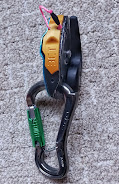
GG LRS Mods - Introduction*

Note: if you landed here and are interested in other blog topics I’ve posted about related to climbing, TRS or LRS, or other devices, please scroll down through the chronological listing of my posts. For the time being, I'm keeping this at the top
This is a dynamic index to my Grigri modifications for LRS (Lead Rope Solo). The index will be added to and updated as I have time - it’s a tug of war between experimenting, researching half-baked ideas, documenting past/present in-progress/and completed projects with actual climbing! 😕 I should note that many mods may not have lots of proven use and data behind them, and thus should be approached with caution and care. I hope to publish cautions and failures also, so that others can learn from and build upon should they desire.
The index and links to posts are for archival and documenting purposes only (or possible entertainment - ‘shits & giggles’). If you utilize this information, you do so at your own risk and YOU take full responsibility.
(Background: I had wanted to start a separate, invitation-only, climbing list on Discord called: Freaks and Geeks: Cutting Edge Rope Solo Ideas and Experiments. However, I didn’t want the responsibility of setting membership criteria (it’s not for all rope soloists) and moderating the group itself. So this index documents my personal ideas, experiments and practices so far. Most of the mods are for the GG+ and GG 2019. However, a few will apply to the Neox and GG 2 which will be noted.)
Disclaimer: Rope soloing is dangerous. You should not rope solo unless you are experienced in lead climbing, top rope soloing, and self-rescue techniques. Using a stock or modified Grigri for rope soloing is beyond the manufacturers approved use of the device and voids the warranty. It may ruin your device, and could easily lead to injury and death. GG mods for rope soloing is an advanced level topic and is only the last method that should be used to advance climbing performance. Experience; systems knowledge; backup methods; physical training; and developed wisdom…all by FAR take priority over modding a GG for hoped for improved performance. Anything that actually involves modifying the Grigri by cutting, grinding, gluing, etc. should only be done by a skilled, experienced and confident tinkerer!
Index
Introduction and logical ordering of mods
Grigri HUR methods (held upright) - an Introduction - coming
A) Plastic spine - done
B) Pivoting Cover - done
2. Non-drilling
A) Loop through pivoting side plate - done
C) BCT GG modifier
D) Steel tab - done
E) Plastic tab - done
F) Epoxy putty - proposed
Chest harness release connections - for increasing the likelihood it will catch an inverted fall
Grigri rope tab modifications: intro and warning
2) Rope guide finger on pivoting side plate (GG+ only)
3). Epoxy putty fillet GG+ only
Cam Arm Spring Mods (for controlling lockup)
2. Spring tension release
A) GG 2019 - Grinding end of spring off
B) Pushing Spring End inside of body (GG 2/GG 2019) - coming
3. Adjustable Magnetic Cam Arm Release (GG2019/Neox-spring disabled or removed) - in progress




































